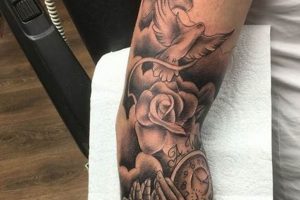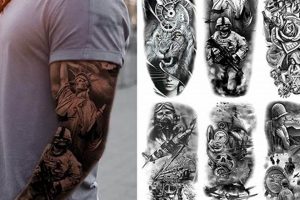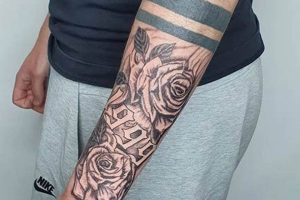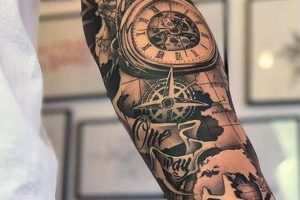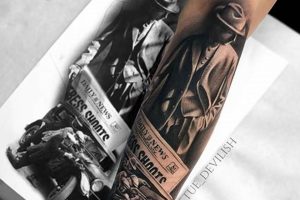A sleeve tattoo utilizes the entire arm as a canvas, requiring a cohesive design that incorporates various elements working in harmony. The “background” refers to the foundational imagery that ties these elements together, creating visual depth and a unified aesthetic. This can range from simple shading and geometric patterns to intricate landscapes, abstract designs, or textures that complement the main focal points of the tattoo. For example, a sleeve featuring prominent Japanese-style koi fish might incorporate flowing water and cherry blossoms as background elements.
Choosing a compelling foundation is critical for the overall impact of a full sleeve tattoo. It provides context and visual interest, enhancing the prominence of foreground elements and creating a more immersive, narrative experience. A well-chosen background can also help balance the composition, ensuring a visually appealing design that avoids appearing cluttered or disjointed. Historically, larger-scale tattooing practices, like those found in Polynesian cultures, emphasized the importance of interconnected patterns and motifs, which serve a similar function to modern background elements.
The following sections will explore various styles and motifs commonly employed as background elements in sleeve tattoos, providing inspiration and practical guidance for those considering this significant artistic commitment. These range from traditional Japanese and tribal designs to more contemporary styles like biomechanical and realism, offering a wide spectrum of aesthetic possibilities.
Tips for Choosing Sleeve Tattoo Backgrounds
Careful consideration of background elements is essential for creating a successful and visually appealing sleeve tattoo. The following tips offer guidance for navigating this crucial design aspect.
Tip 1: Consider Overall Theme and Style: The background should complement the main design elements and contribute to the overall theme. A realistic portrait sleeve might benefit from subtle shading or a blurred background, while a traditional Japanese sleeve might incorporate waves, clouds, or geometric patterns.
Tip 2: Research Different Background Styles: Explore various artistic styles and motifs to find inspiration. Research traditional tattooing practices, contemporary art movements, and natural patterns to broaden design possibilities.
Tip 3: Prioritize Flow and Cohesion: The background should seamlessly connect the different elements of the sleeve, creating a cohesive and unified design. Avoid jarring transitions or disparate styles that clash with the overall composition.
Tip 4: Balance Detail and Negative Space: A cluttered background can detract from the main focal points. Strategically incorporate negative space to provide visual breathing room and emphasize key elements.
Tip 5: Consult with a Skilled Tattoo Artist: A professional tattoo artist can offer valuable insights and guidance on background selection, placement, and execution. They can help refine design ideas and ensure a harmonious composition.
Tip 6: Think Long-Term: Sleeve tattoos are a significant commitment. Consider how the chosen background will age over time and choose timeless designs that will maintain their appeal.
Tip 7: Start with a Solid Foundation: A well-executed background lays the groundwork for a successful sleeve tattoo. Prioritizing this foundational element sets the stage for a cohesive and visually impactful design.
By following these tips, individuals can ensure that the background of their sleeve tattoo enhances the overall design, creating a cohesive and visually stunning piece of art.
These considerations are crucial for ensuring a successful and enduring sleeve tattoo that reflects personal style and artistic vision.
1. Theme
Thematic consistency is paramount when designing a sleeve tattoo. The background must seamlessly integrate with the overarching theme, serving as a cohesive backdrop that enhances the primary design elements. A clear theme provides direction and ensures all components work harmoniously. For instance, a nautical-themed sleeve might incorporate waves, ropes, and compasses as background elements to complement a central image of a ship. Conversely, a sleeve focused on biomechanical elements would likely utilize gears, pistons, and metallic textures as background components. Without a defined theme, the background risks appearing disjointed and detracting from the overall composition.
Establishing a robust theme provides a framework for selecting appropriate background elements. This thematic framework guides color palettes, imagery, and overall stylistic choices. A nature-inspired sleeve featuring animals might utilize forest or mountain landscapes as background elements, reinforcing the theme and creating a visually immersive experience. Similarly, a sleeve exploring themes of mythology might incorporate relevant symbolic imagery and patterns in the background to enhance the narrative. The theme acts as a unifying force, preventing the background from becoming a chaotic collection of unrelated elements.
A well-defined theme elevates a sleeve tattoo from a collection of individual images to a cohesive narrative. It allows the background to play a crucial role in storytelling, adding depth and meaning to the overall design. Understanding the importance of thematic consistency is crucial for both the artist and the individual receiving the tattoo. This ensures a harmonious and visually captivating final product that effectively communicates the intended narrative and artistic vision.
2. Style
Style significantly influences the effectiveness of background elements in sleeve tattoos. A chosen style dictates the appropriate motifs, color palettes, and overall aesthetic. This stylistic consistency ensures the background complements the main design elements rather than competing with them. For example, a Japanese-style sleeve often incorporates traditional imagery like waves, clouds, or cherry blossoms, rendered with bold lines and vibrant colors. Conversely, a realistic sleeve might utilize subtle shading and detailed textures to create a three-dimensional effect, avoiding stylized elements that would clash with the overall realism.
Different styles offer diverse approaches to background design. Geometric patterns lend themselves to structured and symmetrical backgrounds, creating a sense of order and precision. Tribal styles often incorporate bold, black ink designs with intricate patterns that symbolize cultural heritage or personal meaning. Watercolor styles, characterized by their fluid and vibrant color gradients, can create dreamlike and ethereal backgrounds. The chosen style informs the artist’s technique and the visual impact of the final piece. Understanding the nuances of various styles allows for informed decisions that align with the individual’s aesthetic preferences and the overall theme of the sleeve.
Careful consideration of style is crucial for a cohesive and impactful sleeve tattoo. The background style must harmonize with the foreground elements and contribute to the overall narrative. A poorly chosen style can disrupt the visual flow and detract from the main design. Therefore, selecting a style that aligns with both the individual’s vision and the chosen theme is paramount. This stylistic coherence ensures the background enhances the sleeve’s overall aesthetic, creating a unified and visually compelling work of art.
3. Cohesion
Cohesion in sleeve tattoo design refers to the seamless integration of background elements with the main subject matter. A cohesive background supports and enhances the primary images, creating a unified and visually appealing composition. Lack of cohesion results in a disjointed appearance, where the background distracts from rather than complements the overall design. A successful sleeve utilizes background elements to create a narrative flow, guiding the viewer’s eye across the arm and connecting disparate elements into a harmonious whole. For example, a sleeve featuring a central dragon could incorporate swirling smoke and flames as background elements, creating a sense of movement and drama while maintaining a cohesive visual narrative. Conversely, an unrelated background, such as a geometric pattern, might clash with the organic nature of the dragon, disrupting the visual flow and diminishing the overall impact.
The importance of cohesion extends beyond aesthetics. It contributes to the tattoo’s legibility and impact. A cohesive background provides context and depth, allowing the main design elements to stand out. Imagine a sleeve depicting a forest scene. A cohesive background might include subtle details like foliage, shadows, and dappled sunlight, enhancing the realism and depth of the main subject, perhaps a stag. Without these cohesive elements, the stag might appear isolated and lacking context. Cohesion allows the artist to create a more immersive and engaging experience for the viewer, weaving a visual story that unfolds across the entire arm. Furthermore, a well-integrated background minimizes the risk of the tattoo appearing cluttered or overwhelming, ensuring a balanced and aesthetically pleasing composition.
Achieving cohesion requires careful planning and execution. Elements such as color palette, style, and motif must work together harmoniously. A skilled tattoo artist considers the interplay between foreground and background, ensuring a seamless transition and visual balance. The background should never overshadow the primary subject but rather enhance its presence and contribute to the overall narrative. Challenges arise when incorporating multiple disparate elements into a single sleeve design. In these cases, a cohesive background becomes even more critical, serving as a unifying factor that ties everything together. Ultimately, a cohesive sleeve tattoo demonstrates a mastery of design principles, resulting in a visually captivating and meaningful piece of art that stands the test of time.
4. Placement
Placement of background elements within a sleeve tattoo significantly impacts the overall composition and effectiveness of the design. Strategic placement guides the viewer’s eye, creates visual balance, and enhances the interplay between foreground and background elements. Careful consideration of placement ensures a harmonious and aesthetically pleasing result, maximizing the impact of both the main design and the supporting background.
- Visual Flow and Composition
Placement dictates the visual flow of the tattoo, guiding the viewer’s eye across the arm. Background elements can be strategically positioned to create a sense of movement and depth, leading the eye towards focal points. For example, flowing lines and patterns can create a sense of dynamism, while strategically placed shading can add depth and dimension. Poor placement can disrupt this flow, resulting in a cluttered or disjointed appearance. Careful consideration of how the background interacts with the contours of the arm is crucial for achieving a natural and visually appealing flow.
- Emphasis and Focal Points
Background placement plays a crucial role in emphasizing key elements of the design. Subtle background details around a focal point can draw attention and enhance its prominence. Conversely, busy or distracting background elements placed near a focal point can diminish its impact. Consider a portrait within a sleeve; a muted background behind the face emphasizes the portrait, while a vibrant, detailed background might detract from it. Skilled tattoo artists use background placement to create visual hierarchy, guiding the viewer’s attention to the most important aspects of the design.
- Balance and Harmony
Placement contributes to the overall balance and harmony of the sleeve. Distributing background elements evenly across the arm can prevent the design from feeling too heavy or unbalanced in one area. For instance, a sleeve with a large, detailed image on the upper arm might benefit from a lighter, less intricate background on the forearm to maintain visual equilibrium. Strategic use of negative space also plays a role in achieving balance, preventing the design from feeling overcrowded.
- Interaction with Body Contours
The curvature and contours of the arm influence background placement decisions. Background elements should flow naturally with the body’s shape, enhancing rather than fighting against its natural lines. A skilled artist considers how the design will wrap around the arm, adjusting placement to complement the body’s contours. This consideration is especially important for elements that wrap around the arm, such as bands, vines, or geometric patterns. Careful placement ensures the background complements the body’s form, creating a seamless and integrated piece of art.
Effective placement of background elements is essential for a well-executed sleeve tattoo. By considering visual flow, emphasis, balance, and the body’s natural contours, a skilled artist can create a cohesive and visually captivating design. Understanding the importance of placement allows for informed decisions that enhance the overall impact and longevity of the sleeve tattoo, transforming it into a truly integrated piece of body art.
5. Detail
Detail within a background significantly impacts the overall aesthetic and narrative depth of a sleeve tattoo. The level of detail must be carefully considered to enhance, not overwhelm, the primary design elements. Balancing intricate details with negative space is crucial for achieving a harmonious and visually appealing composition. Overly detailed backgrounds can appear cluttered, detracting from the main subject matter, while a lack of detail can result in a flat and uninteresting design. This section explores the nuances of detail in sleeve tattoo backgrounds, examining how varying levels of intricacy contribute to the overall impact and longevity of the piece.
- Intricacy and Complexity
Intricate details, such as fine lines, delicate patterns, or subtle shading, can add depth and visual interest to a background. Examples include meticulously rendered textures like wood grain, scales, or fabric folds. However, excessive intricacy can lead to a visually overwhelming and cluttered appearance, particularly in larger-scale pieces like sleeve tattoos. The level of intricacy should be proportionate to the overall design and the size of the canvas. A highly detailed background might work well for a smaller element within the sleeve, but could become overwhelming if applied across the entire arm. Careful consideration of scale and balance is essential when incorporating intricate details.
- Visual Depth and Dimension
Detail contributes to the creation of visual depth and dimension within a tattoo. Subtle shading, highlights, and variations in line weight can create the illusion of three-dimensionality, making the background appear more realistic and engaging. For instance, a background depicting a landscape can be made more immersive through the use of atmospheric perspective and detailed rendering of foliage. This adds depth and draws the viewer into the scene. However, excessive detail can sometimes flatten the image, especially if not executed skillfully. A skilled tattoo artist understands how to use detail strategically to enhance depth without sacrificing clarity.
- Balance with Negative Space
The interplay between detail and negative space is crucial for a successful sleeve tattoo. Negative space, the areas left intentionally blank or un-inked, provides visual breathing room and prevents the design from appearing too dense or overwhelming. A background with intricate details benefits from strategically placed negative space to balance the composition. For example, a detailed floral pattern might be interspersed with areas of bare skin to highlight the intricacy of the flowers and prevent the design from feeling cluttered. The balance between detail and negative space contributes to the overall harmony and visual appeal of the sleeve.
- Impact on Longevity
The level of detail in a tattoo can affect its longevity. Highly detailed tattoos, particularly those with fine lines and intricate patterns, are more susceptible to fading and blurring over time. Factors like sun exposure, skin type, and the quality of the ink can influence how well the detail holds up over the years. While intricate details can create a stunning initial impact, it’s important to consider how they might age. A skilled tattoo artist can advise on appropriate levels of detail for long-term visual appeal, suggesting techniques and placement strategies that minimize the risk of premature fading or blurring. Sometimes, less detail can be more effective in ensuring a tattoo remains visually appealing for years to come.
The level of detail in a sleeve tattoo background plays a crucial role in its overall success. Careful consideration of intricacy, depth, balance with negative space, and long-term impact ensures a cohesive and visually appealing design that enhances the main subject matter. A skilled artist understands how to utilize detail strategically to create a tattoo that not only looks stunning initially, but also maintains its beauty and impact over time. Finding the right balance between detail and simplicity is key to achieving a truly exceptional and enduring piece of body art.
6. Longevity
Longevity is a critical factor when considering background elements for a sleeve tattoo. A sleeve represents a significant investment of time, money, and personal expression, therefore ensuring the design remains visually appealing for years to come is paramount. Background choices directly impact a sleeve’s longevity, influencing how well the tattoo ages and resists fading or blurring. Factors such as ink quality, color saturation, and design complexity contribute to a tattoo’s ability to withstand the test of time. A poorly chosen background can detract from the overall aesthetic as the tattoo ages, potentially requiring costly and time-consuming touch-ups or cover-ups.
Several design choices contribute to a background’s longevity. Simple, bold lines tend to age better than intricate details, which are more susceptible to blurring. Darker, saturated colors typically retain their vibrancy longer than lighter shades. Large, solid areas of color are less prone to fading compared to intricate color gradients. Background elements that incorporate these principles are more likely to maintain their visual appeal over time. For instance, a traditional Japanese-style background with bold outlines and solid blocks of color is likely to age better than a delicate watercolor background with subtle shading and intricate details. The choice of background should also complement the overall design and theme, ensuring a cohesive aesthetic that remains impactful over time.
Beyond aesthetic considerations, longevity also relates to the background’s ability to adapt to changes in the body. Skin stretches and changes over time due to factors like aging, weight fluctuations, and sun exposure. Background elements that can accommodate these changes without significant distortion are essential for long-term visual appeal. Simple, geometric patterns or large-scale designs tend to hold up better than intricate details or small, tightly packed elements. Consulting with a skilled tattoo artist is crucial for selecting a background that not only complements the overall design but also considers the long-term effects of aging and skin changes. Careful planning and consideration of these factors contribute significantly to a sleeve tattoo that remains a source of pride and personal expression for years to come.
Frequently Asked Questions about Sleeve Tattoo Backgrounds
This section addresses common inquiries regarding background elements in sleeve tattoos, providing clarity and guidance for those considering this extensive form of body art.
Question 1: How important is the background in a sleeve tattoo?
The background serves as the foundation of a sleeve tattoo, unifying disparate elements and creating a cohesive visual narrative. A well-chosen background enhances the main design, adding depth, context, and visual interest.
Question 2: What are popular background styles for sleeve tattoos?
Popular styles include geometric patterns, traditional Japanese imagery (waves, clouds, cherry blossoms), biomechanical elements, and realistic depictions of landscapes or textures. The chosen style should complement the overall theme and subject matter of the sleeve.
Question 3: How can one ensure background cohesion within a sleeve?
Cohesion is achieved through consistent use of style, color palette, and motif. The background should seamlessly integrate with the main design elements, creating a unified visual flow and supporting the overall narrative.
Question 4: How does background detail impact a sleeve’s longevity?
Intricate details can fade more quickly than bold lines and solid colors. The level of detail should be carefully considered in relation to the desired longevity of the tattoo. Simpler designs often age better.
Question 5: What is the role of negative space in sleeve backgrounds?
Negative space provides visual breathing room, preventing the design from feeling overcrowded. Strategic use of negative space can enhance the impact of detailed areas and create a more balanced composition.
Question 6: How does one choose the right background for a sleeve tattoo?
Thorough research, consultation with a skilled tattoo artist, and careful consideration of personal style, thematic preferences, and long-term goals are essential for choosing a suitable background.
Careful consideration of these frequently asked questions provides valuable insight into the crucial role backgrounds play in successful sleeve tattoo design. Addressing these concerns beforehand ensures a more informed and satisfying tattooing experience.
The following section will delve into specific examples of popular background motifs and their application in sleeve tattoos, offering further inspiration and guidance.
Background Tattoo Ideas Sleeve
Exploration of background elements within sleeve tattoo design reveals their crucial role in achieving a cohesive and visually compelling final product. Careful consideration of theme, style, cohesion, placement, detail, and longevity ensures a harmonious composition that complements the main subject matter and stands the test of time. Effective backgrounds provide context, depth, and visual interest, transforming a collection of individual elements into a unified narrative. Understanding the interplay between foreground and background is essential for maximizing the impact and artistic expression of a sleeve tattoo.
Ultimately, a successful sleeve tattoo transcends mere decoration; it becomes a powerful form of self-expression and storytelling. The background, often overlooked, plays a pivotal role in this narrative, adding layers of meaning and visual richness. Choosing a background requires thoughtful consideration and collaboration with a skilled artist. This ensures a design that not only captures individual vision but also remains a source of personal pride and aesthetic appreciation for years to come. The enduring impact of a well-executed sleeve underscores the importance of thoughtful background design in achieving a truly exceptional and lasting piece of body art.



